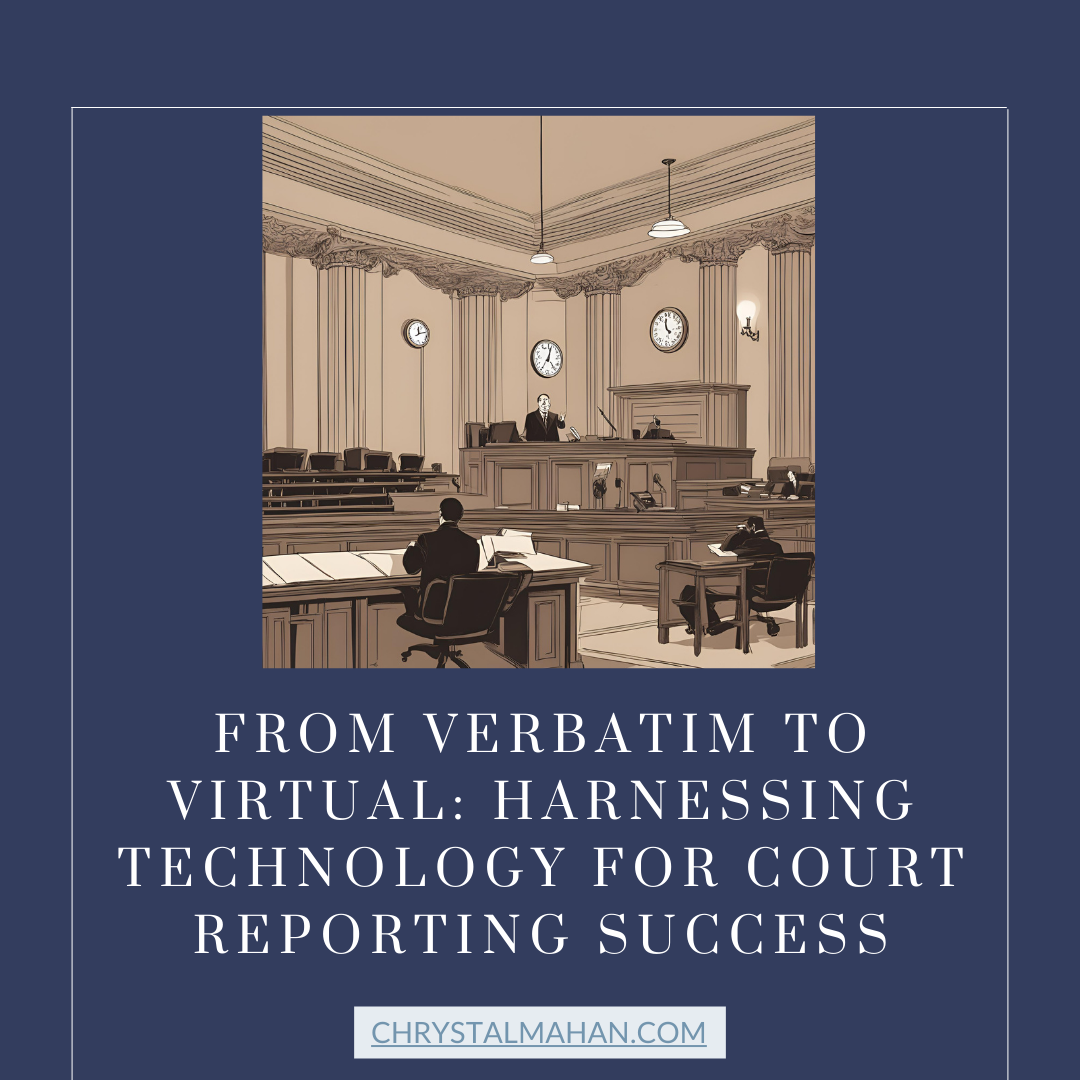From Verbatim to Virtual: Harnessing Technology for Court Reporting Success


Photo Credit: Cancva, AI-Generated
Traditional professions are evolving faster than ever in a world increasingly driven by technology. Court reporting, long associated with stenographers typing away in the courtroom, has witnessed a digital transformation that has redefined how legal transcripts are created. If you’re in the legal field or aspiring to join it, you might have wondered how these advancements affect the craft of capturing every spoken word accurately. Can technology truly replace the intricate skills of a human court reporter? The short answer: not quite, but it’s making significant strides. This blend of tradition and innovation is ushering in a new era for court reporting, where the power of technology enhances human expertise.
Imagine a future where court reporters no longer lug heavy stenotype machines to the courtroom. Instead, they’re armed with sleek laptops and sophisticated software that automatically transcribes spoken words with uncanny precision. This isn’t science fiction—it’s happening now. While stenographers are still essential for the legal system’s integrity, digital tools are revolutionizing their work, making the process faster, more efficient, and more accurate. If you’re interested in how you can harness these technological advancements for your court reporting success, you’re in the right place. This post will guide you through the most transformative tools available today and how to make the most of them.
As we explore the exciting intersection of court reporting and technology, you’ll learn how digital tools like real-time reporting software, AI-assisted transcription, and cloud storage can dramatically enhance your work. Whether you’re a seasoned court reporter or just beginning your journey, leveraging technology is the key to staying competitive in this evolving field. Let’s dive into how you can blend your verbatim skills with the latest tech to achieve court reporting success.
The Evolution of Court Reporting
Court reporting has long been a crucial part of the legal system, with stenographers responsible for producing accurate, verbatim transcripts of courtroom proceedings. Traditionally, this has involved using a stenotype machine, shorthand, and an extensive vocabulary of legal terms to ensure that every spoken word is captured accurately. However, the rise of digital tools is transforming this traditional craft. Today, court reporters can supplement their stenography skills with cutting-edge technology, streamlining processes, improving accuracy, and enhancing accessibility.
One of the most significant changes is the shift towards real-time reporting. Court reporters can now provide instant transcripts during a trial, giving lawyers, judges, and other courtroom participants immediate access to the dialogue. This leap forward has been facilitated by advancements in both hardware and software, enabling court reporters to type faster and with fewer errors. Additionally, integrating AI-assisted transcription programs allows reporters to check their work against automated suggestions, blending human expertise with machine precision.
Despite these advancements, the court reporter’s role is far from obsolete. Human oversight is essential to catch errors and ensure that nuances in language—such as sarcasm, tone, and emphasis—are captured correctly. As such, the court reporter’s expertise remains indispensable, even as technology makes their job easier. Combining these tools with traditional skills is key to success in the modern court reporting landscape.
Leveraging Real-Time Reporting Tools for Instant Results
Real-time reporting has become a game-changer for court reporters, enabling them to produce immediate transcripts during live courtroom sessions. This technology uses advanced software that translates shorthand keystrokes into plain text on a screen within seconds. Lawyers and judges can instantly reference testimony, allowing them to make quick decisions and strategy adjustments on the spot.
For court reporters, real-time reporting tools benefit not just speed but also accuracy. As the software automatically converts their shorthand into text, reporters can focus on maintaining the transcription flow without getting bogged down by typos or delays. These tools also come with customizable dictionaries, ensuring that legal terminology, jargon, and case-specific names are captured accurately.
To get the most out of real-time reporting tools, investing time in training and practice is crucial. While the technology is intuitive, mastering the software and understanding its full range of features can take time. However, once you’re proficient, real-time reporting offers a significant competitive edge, positioning you as a valuable asset in any courtroom setting.
The Role of AI in Transcription: Assistance, Not Replacement
Artificial intelligence (AI) has made significant inroads into the court reporting industry, primarily through transcription tools that automatically convert audio into text. Often fueled by machine learning algorithms, these programs continuously improve as they process more data, offering higher accuracy rates over time. However, while AI transcription tools are impressive, they are not yet advanced enough to fully replace human court reporters.
AI is particularly useful for tasks like rough draft creation, allowing court reporters to produce a first-pass transcription that they can later refine. It can also help with time-consuming tasks like formatting and organizing transcripts, freeing up reporters to focus on quality control. However, AI struggles with complex speech patterns, accents, and the nuances of legal dialogue, which is why human oversight remains critical.
Understanding how to incorporate AI into their workflow can lead to greater efficiency and productivity for court reporters. Rather than seeing AI as a threat, consider it an invaluable assistant that can handle the mundane aspects of transcription while you concentrate on the finer details.
Cloud Storage and Data Security: Protecting Your Transcripts
Data management is one of the less glamorous but equally important aspects of modern court reporting. As court reporters handle sensitive legal information, ensuring that transcripts are securely stored and easily accessible is crucial. Enter cloud storage—a solution that allows reporters to save, organize, and retrieve their work from anywhere with an internet connection.
Using cloud storage services ensures that transcripts are backed up, protected from loss, and accessible anytime, offering convenience that physical storage methods simply can’t match. Moreover, many cloud services offer encryption and advanced security features to safeguard sensitive data, addressing one of the legal industry’s primary concerns: confidentiality.
Investing in a reliable cloud storage solution is a no-brainer for court reporters looking to streamline their operations. Not only does it reduce the risk of losing important files, but it also makes it easier to collaborate with other legal professionals. In case of a system failure or hardware crash, you can rest assured that your work is safe and sound in the cloud.
Continuous Learning: Staying Ahead in the Age of Innovation
Court reporting is a profession that requires lifelong learning, especially as technology continues to evolve. Keeping up with new tools, software updates, and best practices can significantly impact your ability to stay competitive in the field. Online courses, certification programs, and webinars offer valuable opportunities to learn new skills and refine existing ones, helping you harness the latest technological advances.
Additionally, joining court reporting communities and forums can provide valuable insights into emerging trends and technologies. Networking with peers and attending industry conferences can also help you stay up-to-date on the latest developments. By committing to continuous learning, you ensure that you remain at the forefront of the profession and can offer cutting-edge services that meet the demands of modern legal proceedings.
While technology is an incredible tool, it’s important to remember that the foundation of court reporting remains the same: accuracy, attention to detail, and professionalism. Mastering the balance between tradition and innovation is the key to achieving long-term success in this rapidly changing field.
Moving Forward with Confidence
As the court reporting field evolves, so must the professionals who practice it. By embracing new technologies—whether it’s real-time reporting, AI-assisted transcription, or cloud storage—you can enhance your skills and stay competitive in an increasingly digital world. The future of court reporting is bright, but only for those willing to adapt and grow alongside the tools designed to make their work more efficient and precise.
As you continue your journey toward court reporting success, remember that technology is an ally, not a replacement. Mastering the tools available to you will improve your workflow and ensure that you remain an essential part of the legal process.
Join Me for Coffee
Want to dive deeper into how technology can boost your career? Check out more posts on Nevermore Lane, where I explore magical ways to balance modern innovation with traditional expertise. And if you’re looking for a more personal chat, join me for coffee—we can discuss how you’re navigating this exciting shift in court reporting! And, if you are a court reporter in need of an extra set of hands, I have availability to help.
Like what you read? Drop me a line – let’s chat over virtual coffee.
~ Chrystal






